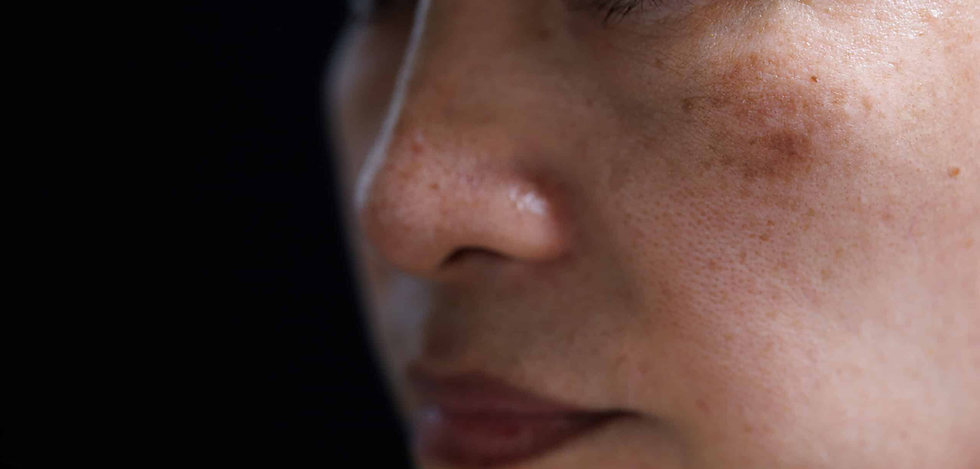What Are the Most Popular Melasma Treatment?
- aesthatic clinic
.jpg/v1/fill/w_320,h_320/file.jpg)
- Nov 20, 2024
- 3 min read
Melasma, a common skin condition characterized by dark patches, requires specialized care to manage effectively. The demand for innovative and efficient melasma treatments has grown significantly, offering individuals a variety of options to restore their skin's even tone and confidence. Below is a comprehensive look at the most popular melasma treatment techniques available today. This Article delves into the details of Melasma Treatment in Dubai.
Understanding the Goals of Melasma Treatment
Melasma treatments aim to reduce pigmentation, prevent further discoloration, and improve skin texture. These treatments vary in their approach, catering to different skin types and severities of melasma.
Topical Treatments for Melasma
Hydroquinone Creams
Hydroquinone is one of the most widely prescribed treatments for melasma. It works by inhibiting melanin production, thereby lightening dark patches over time.
How It Works: Applied directly to the affected areas, hydroquinone gradually fades discoloration.
Effectiveness: Noticeable improvements are typically seen within 8 to 12 weeks of consistent use.

Retinoids and Combination Creams
Retinoids, often combined with other agents like hydroquinone or corticosteroids, accelerate skin cell turnover. This helps in removing pigmented cells and reducing the appearance of melasma.
Benefits: Combination creams provide a multi-action approach to target pigmentation and improve skin texture.
Azelaic Acid and Kojic Acid
These are gentler alternatives that lighten pigmentation and work well for individuals with sensitive skin.
Usage: Ideal for mild cases or as part of a maintenance routine.
Chemical Peels
Chemical peels involve applying a chemical solution to the skin to exfoliate the top layer, allowing new, evenly toned skin to emerge.
Types of Chemical Peels
Glycolic Acid Peels: Ideal for mild to moderate melasma, they work by exfoliating the skin gently.
Salicylic Acid Peels: These are better suited for individuals with oily or acne-prone skin.
Trichloroacetic Acid (TCA) Peels: Effective for deeper pigmentation issues, TCA peels provide more dramatic results.
Advantages
Accelerated removal of pigmented cells.
Improvement in skin texture and tone.
Laser and Light-Based Treatments
Fractional Lasers
Fractional lasers, such as Fraxel, target pigmented cells while minimizing damage to surrounding skin.
Effectiveness: Best for persistent melasma cases unresponsive to topical treatments.
Intense Pulsed Light (IPL)
IPL delivers broad-spectrum light to target melanin in the skin. It is effective for surface-level pigmentation but may not be suitable for deeper melasma.
Low-Level Lasers
Low-level lasers, like Q-switched lasers, are gentler and specifically designed for melasma. These treatments are less likely to cause post-inflammatory hyperpigmentation.
Microneedling for Melasma
Microneedling involves creating tiny punctures in the skin using fine needles, stimulating collagen production and allowing for better absorption of topical treatments.
Benefits: Improves the appearance of melasma and enhances the efficacy of other treatments.
Suitability: Effective for individuals with textural concerns alongside pigmentation.
Oral Medications
Tranexamic Acid
Tranexamic acid, taken orally, works by reducing the skin’s melanin production. It is often recommended for individuals with stubborn or severe melasma.
Usage: Prescribed as a short-term solution alongside topical treatments or procedures.
Non-Invasive Procedures
Dermaplaning
Dermaplaning involves using a surgical blade to exfoliate the top layer of skin. This technique helps in removing dead skin cells and pigmentation.
Advantages: Improves skin texture and allows for better penetration of skincare products.
Microdermabrasion
Microdermabrasion gently exfoliates the outer skin layer using a fine abrasive tool. This is a suitable option for mild pigmentation issues.
Natural and Preventive Approaches
Sun Protection
Consistent use of broad-spectrum sunscreen is crucial in preventing melasma from worsening. Sunscreen minimizes UV exposure, which is a major trigger for melasma.
Antioxidant Serums
Products rich in Vitamin C and other antioxidants help in brightening the skin and reducing pigmentation.
Combining Techniques for Best Results
Many individuals benefit from a combination of treatments tailored to their specific needs. For example:
A regimen combining topical creams and chemical peels.
Pairing microneedling with tranexamic acid or other serums.
Using lasers for stubborn patches while maintaining results with sunscreen and antioxidants.
Conclusion
The most popular melasma treatment techniques include topical solutions, chemical peels, lasers, and microneedling, among others. Each option has its unique benefits and is chosen based on the severity of the condition and the individual’s skin type. With professional guidance and a tailored treatment plan, individuals can achieve significant improvements in pigmentation, restoring both their skin’s appearance and confidence.









Comments